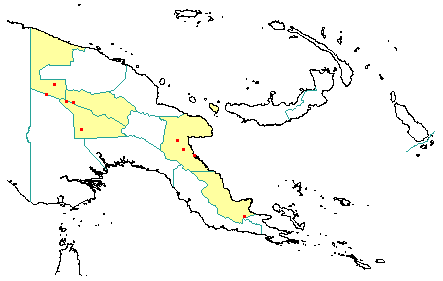
in PNGplants database
PNGTreesKey – Myristica crassipes Warb. |
Barry Conn (NSW) & Kipiro Damas (LAE).
Guide to trees of Papua New Guinea
Copyright held by the authors, National Herbarium of New South Wales, and Papua New Guinea National Herbarium
Flora der Deutschen Schutzgebiete in der Südsee 326 (1900)
Other Literature: D.B. Foreman, Handbooks of the Flora of Papua New Guinea 190-192 (1978)
Family: Myristicaceae
Dicotyledon
Timber Group: Commercial hardwood
Field Characters: Large canopy tree (up to 30 m high) or Small sub-canopy tree; Bole cylindrical; straight; buttresses buttresses absent; spines spines absent; aerial roots aerial roots absent; stilt roots stilt roots absent; Bark dark grey, dark brown, or greyish black, slightly rough, scaly or flaky (with small falkes) or fissured; Subrhytidome (under-bark) red; less than 25 mm thick; bark blaze consisting of one layer; faintly to non-aromatic; outer blaze red or brown, markings absent; inner blaze red or brown, markings absent; bark exudate (sap) present, red, not readily flowing (spotty), colour changing on exposure to air, to brown or red, sticky; terminal buds not enclosed by leaves.
Indumentum: Complex hairs absent; stinging hairs absent; mature twig indumentum (hairs) present or absent, hairs dense (minutely hairy).
Leaves: Leaves spaced along branches, spiral (leaves occurring singly at a node and arranged spirally up the branchlet), simple (a leaf composed of a single blade); petiole present, not winged, attached to base of leaf blade, not swollen; leaves broadest at or near middle or slightly broadest below middle, (4.0-) 7.0-15.0 (-20.0) cm, 2.5-5.0 (-6.5) cm; symmetric, entire, not dissected or lobed, obtuse or acute, venation pinnate, secondary veins open, prominent, intramarginal veins absent; leaves lower surface blue-green or pale green, upper surface green, indumentum (hairs) absent when mature or present when immature, indumentum (hairs) dense or sparse; absent; domatia absent; stipules absent.
Flowers: Inflorescence axillary, flowers on an unbranched axis or flowers on a branched axis, cones absent; flowers unisexual, unisexual with male and female flowers on the same plant, stalked, flowers with many planes of symmetry, 5.0-10.0 mm long, diameter small (up to10 mm diam.); perianth present, with all sepals and/or petals (hence tepals) similar, inner perianth pale yellow, pale orange, pale brown, or cream-coloured; 2-3 (-5), some or partly joined; stamens 8-30, absent, joined, free of the perianth; ovary superior, carpels joined (when more than one), locules 1; styles absent.
Fruits: Infrutescence single or arranged on unbranched axis (with fruits in pairs), fruit 55.0-70.0 mm long, yellow or greenish brown, not spiny, fleshy, simple, dehiscent, capsule; seeds 1, much more than 10 mm long (15-20 mm long), not winged, broad (as wide as long), seed more than 10 mm diam. (c. 15 mm diam.).
Distribution: West Sepik, Morobe, Western Highlands, Southern Highlands & Northern.
 | Botanical records in PNGplants database |
Notes: Notes WJ.J.O de Willde, 2000 (Flora Malesiana, Series 1, volume 14, pp. 444-445) recognises three subspecies, namely, subsp. crassipes, subsp. altemontana and subsp. marronia. However, these three infraspecific taxa are not distinguished in this account.